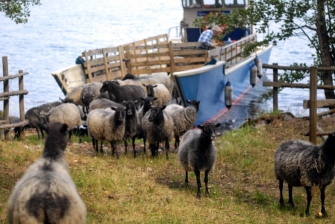Alistair Auffret (Stockholm University) recently had an Essay Review published in Journal of Ecology titled; Plant functional connectivity – integrating landscape structure and effective dispersal. Below, Alistair gives us a background to his paper and more information on the functional connectivity of plants…
Plants, like all other organisms, generally need to be able to move across a landscape. For example, changes in land use can mean that species urgently need to move to a new area of the landscape to survive, and a warming climate means that species will have to move through landscapes to migrate towards the poles or to higher altitudes.

Moving livestock between different areas of a landscape can improve the functional connectivity of plant populations without a change in landscape structure. Photo: Josefin Reimark
The ability that each species has to move (disperse), combined with the layout (or structure) of the landscape is known to affect a species’ functional connectivity. Maintaining and improving functional connectivity in a landscape is important, and is something that has been incorporated into management plans at local, national and international levels to help species survive following environmental change.
Plants are generally stuck in one place and can’t actively choose where to move to. Instead, they rely on wind, water and animals (including humans) to move their seeds and pollen long distances across the landscape and beyond. So to understand functional connectivity for plants, it’s not only a case of thinking about where they are now and where they are going, but also how they are going to get there. Once pollen and seeds arrive in a new place, conditions then have to be suitable for the growth and survival of adult plants. This can be affected by changes in landscape structure, but animals dispersing seeds and pollen can be affected by human activity such as hunting and the arrival of new species to an area. Long-term changes in climate can alter patterns of wind and water flow, affecting functional connectivity for other plant species.

Roads and road verges can either help or hinder movement across a landscape, depending on the species (and the landscape!). Photo: Alistair Auffret
Functional connectivity for plants is complicated, but there are now lots of new methods to help us understand it better. Genetic methods allow us to see exactly how plants in a landscape are related, and other new techniques are helping to explain all the different parts of dispersal process. A better understanding of functional connectivity for plant species should help us to manage and protect species and landscapes that are under threat from human activities.
Alistair Auffret, Stockholm University
Read Alistair’s paper here and also check back next week for another post from Alistair about the challenges of networking in ecology, and how a speculative email led to the collaboration needed for his paper review…




Pingback: Another way to network and collaborate | Journal of Ecology Blog
Nice article showing concerns towards plants